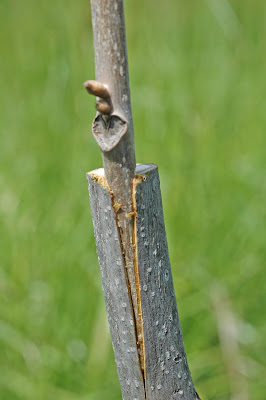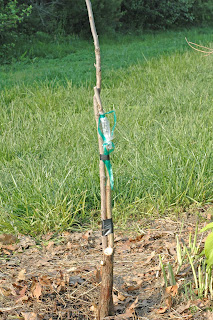The grafting season in SE Kansas is in full swing. These mild, cloudy days we've had lately have been perfect for field grafting. I had a pecan seedling pop up in the yard (photo at right) and its now growing fast enough to provide a good rootstock for a 3 flap graft.
Rootstock growth rate, prior to grafting, is one of the most overlooked factors in determining grafting success. As a general rule, trees should be grafted only after they have grown at least 2 feet of new stem the previous growing season. Weed control and nitrogen fertilizer are two key ingredients for promoting rapid seedling growth.
The first step in making a 3 flap graft is to select a piece of scionwood that is roughly the same diameter at the seedling tree (photo at left). To ensure that there will be plenty of tree energy directed to pushing the graft, I like to place the graft union no higher than half way up the stock tree. This usually means that I use large diameter scionwood (1/2 to 3/4 inch) for 3 flap grafting.
After choosing my scion and the location for graft placement, I cut the stock tree with a pair of pruning shears usually just below a bud. By cutting just below a bud, I ensure that I will have nice clear bark on the stem to create my flaps.
Now I turn my attention to creating the bark flaps on the stock. If I find a bud on the stock within the top 3 inches of the top of the stock, I rub off the bud and make my first slice through the bark right down the middle of the bud (photo at left). This will make peeling back the bark flaps much easier than trying the pull a flap down directly over a bud.
I made this cut about 3 inches long using the tip of my knife to slice the bark straight down the center of the stem. It doesn't take a lot of pressure to make this cut since the bark of a young tree is relatively thin.
The hardest part for some folks in making a 3 flap graft is making 3 equal sized flaps. After making the first slice through the bark, I mark the location of that cut by pressing my knife into the top of the stock. Then I make 2 more marks with the knife to divide the stem into thirds (photo at right). Following the marks on top of the stock, I make 2 more 3-inch-long slices down the center of the stem, just like the first slice.
Once all three cuts have been made into the stock, I tie a 30-inch-long piece of plastic grafting tape onto the stem just below the bottom of the cut (photo at left). Getting the tape in place before peeling the flaps back serves two purposes. The tape will prevent you from pulling back the flap too far and you won't be fumbling around looking for tape when the scion is ready to be inserted into the stock.
At this point I turn my attention to preparing the scion. I use my clippers to cut about 1/2 inch off the bottom of the scion (photo at right). This cut ensures that I have fresh wood and live cambium in the area the graft is made.
Next, I twirl the scion around to see if there are any buds present on the lower 3 inches of the scion. If I find a bud, my first cut is to remove that bud (photo at left). The cut I make is fairly shallow but deep enough to reveal the white wood of the scion. The cut is about 2 3/4 inches long.
The most common mistake folks make in attempting the 3 flap graft is not cutting deep enough into the scion. You must see white wood all way down the cut surface to ensure maximum cambial exposure.
Before making two more cuts on the scion, I hold the scion so I can see the bottom of the wood and mentally divide the scion in thirds. Breaking the boy scout rule, I cut towards myself making each of two more shallow cuts just like the first. After completing the 3 cuts on the scion, I now have triangular shaped bud stick (photo at right). In the photo, note that there is a solid strip of bark left between each shallow cut. With the bark still in place and white wood showing on each cut surface, I am certain to have lots of cambium exposed (For any graft to work, the cambium of the stock must touch the cambium of the scion).

Now that I've got the scion fully prepared, I hold the wood in the pit of my arm to feel up my hands for preparing the flaps (this will keep the cut surfaces on the scion from drying out). Using my thumb nail, I pry the bark of the stock off its wood (photo above). In pulling back the flap, I only touch the upper most part of the flap. Note that I pull back the bark flap all the way down until it hits the pre-placed grafting tape.
I repeat the bark pealing process for the other 2 flaps, then use a pruning shear to clip the wood out of the center of the stock (photo at right). Make sure not to handle the inside of the flaps. Your oily skin can damage the cambium on the inside of the bark flap.
Once the wood is removed, the three bark flaps will spring back upwards. I then grab the tape attached to the stock and start wrapping it around the stem.
As I make one or two wraps around the stem, just above the cut surface of the removed wood, the flaps fill form into a tube. I'm now ready to insert the scion.
I insert the scion into the bark tube while still holding the grafting tape tight. In pressing the scion into place I make sure each cut surface of the scion will be covered completely by a bark flap. Sometimes the scion and bark flaps don't seem to line up just right. When this happens to me, I simply pull the scion out and twirl the scion 1/3 of a turn to see if I get a better fit. Once I'm satisfied with the alignment of scion and stock, I continue to wrap the graft with grafting tape.
In wrapping the graft, I pull the grafting tape tight to compress the bark flaps up flat against the cut surfaces of the scion (photo at right). If one of the flaps gets pulled out of place, I slide the flap back into the right position before continuing to tape up the graft. I wrap all the way up the stem to completely cover the top of the flaps. I then wrap down the graft union to the bottom where I tie the tape in place.
When I'm done wrapping the graft, I can see the triangular shape of the scion (photo at left). I applied the tape so tightly that it has formed the bark to the shape of the scion ensuring maximum cambial contact..
Since I'm grafting out in the field, I like to add some protective coverings to aid in graft callusing (photo at right).
First, I wrap the graft union with a piece of aluminum foil to prevent sun scald. Next, I cut the corner out of a sandwich bag and place over the graft. I use grafting tape to tie the bag above and below the graft union. The plastic bag holds in moisture and acts like a mini green house to warm the graft union.
To complete the grafting process, I dab on a bit of white glue on top of the scion. This seals the cut surface of the bud stick to help prevent excessive moisture loss.
Just like the
bark graft, I always attach a bird perch to the tree to protect the new graft. Even though the 3 flap graft is mechanically stronger than other grafting methods, I have seen plenty of these grafts broken over by perching birds. I attach a pecan branch or bamboo cane to the rootstock to provide a alternative perching site for common song birds (photo at right).
Three weeks from now, I should be able to see the buds on the scion start to push.































































